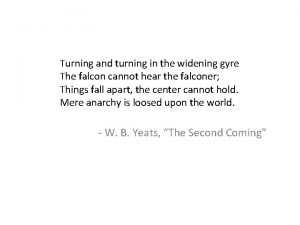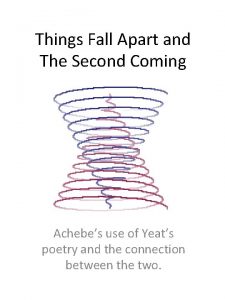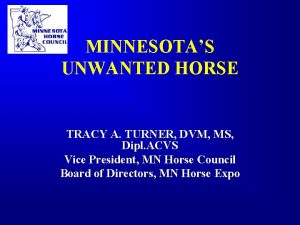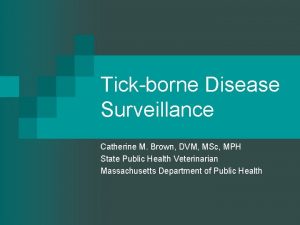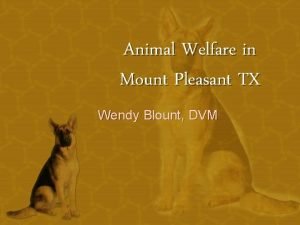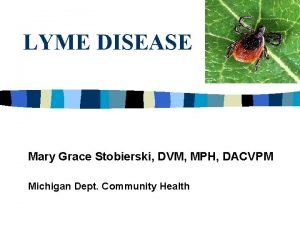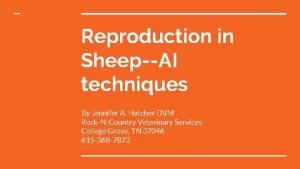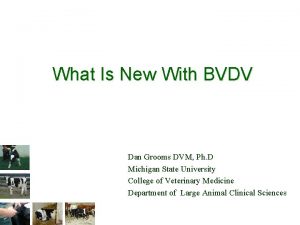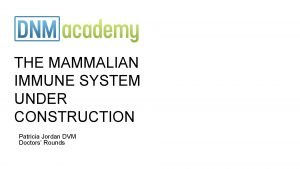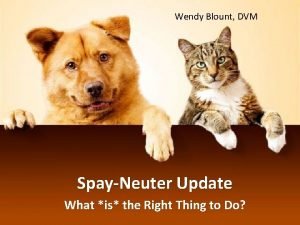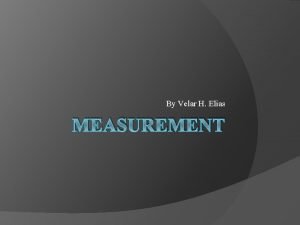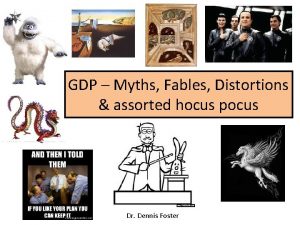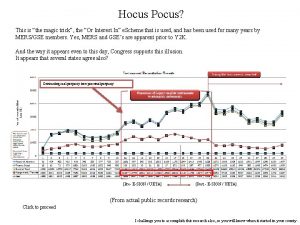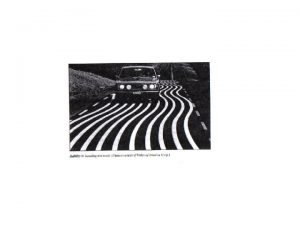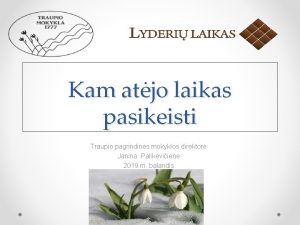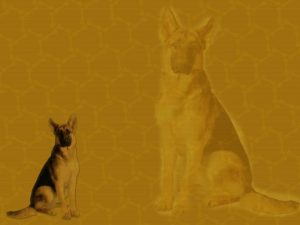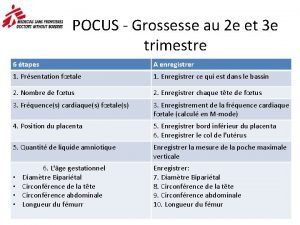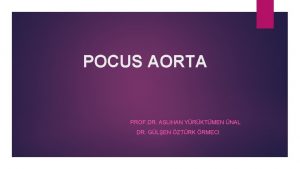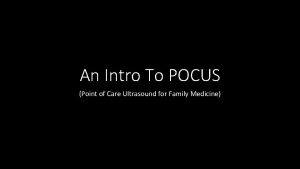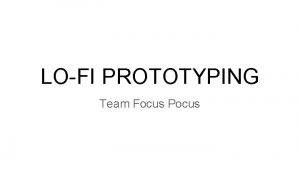Turning hocus pocus into evidence ATJO WESTERHUIS DVM





































- Slides: 37

Turning hocus pocus into evidence ATJO WESTERHUIS DVM | THE NETHERLANDS SOUTH-AFRICA - 9. 10 | 2017

1975 Why I started with Homeopathy Demand for treatment options was/is more than evidence -based AVM can fulfill Symptomatic treatment of AVM Chronic cases: idiopathic, immune mediated … Toxic side effects of AVM … I became fascinated by the results of alternative lay therapist interventions …

What is this …? NOT EVIDENCE BASED. . . !? Hormesis? Potentiating? Dilutions beyond 10 -24? Human Materia Medica? More – than + results? Extreme time investment? … scary successes motivated me to explore whether hom. is magic or reality … Hormesis

Limitations homeopathy in vet. practice Too little knowledge of human and (above all) veterinary MM MM: human patient presentations, lack of modern diagnostic data Repertory: human, lack of skills in using it Succes limited by the own immune potential of the animal In many cases lack of symptoms (!), e. g. In epilepsy and skinproblems

Building towards inductive evidence (1) Methodical working and accurate recording Detailed descriptions of relevant symptoms from history taking (owners presentations!), clinical and additional clinical examinations (in some cases available) Description and argumentation of medication: remedy, potency, dose, frequency and duration of the medication Follow up: monitoring reactions on/during (different) medication(s) and adjustments Echange of knowledge worldwide (!)

Building towards inductive evidence (2) Collecting similar casuistics from different practitioners independent of each other with the same results (worldwide) may provide us: Better veterinary remedy pictures (per animal species) Upgrading symptoms up to key symptom(s)/-combinations (more or less) Higher predictability of our treatment results (more confidence) Higher succes rate (motivating!) Turning experiences into evidence based vet. medicine, at least a good hypothesis

Building towards inductive evidence (3) ICIVM International Conference for Innovative Veterinary Medicine THE NETHERLANDS November 22 -25 | 2017

Building towards inductive evidence (4) Vets & Partners SHARING MULTIDISCIPLINARY EXPERIENCE Edu. Pet Vets & Partners is an internet platform for vets and other professionals in animal health care to share practice experience Starting 1. 1. 20018

Constitutional / Type Aetiology Peculiar Mind General Modality Local Both types have overweight. Type can be a combination of habitus and behaviour. Calcarea carbonica Mental en physical tension. Desperate look. Severe resistance by putting the patient on the examination table; forcing may mean biting. Graphites Mentally en physically slow, apathy. Allows being put on the examination tabel. Sometimes mild grumbling on approaching / touching and then simply quit.

Constitutional / Type Aetiology Peculiar Mind General Modality Local Both types are introverted and may have chronic diarrhea. Aetiology or modality of aggravation. Ignatia amara Ailments from silent grief, especially chronic diarrhea (IBD): periodically colitis. No emaciation. Arsenicum album Ailments from drinking icy cold water, especially chronic diarrhea (IBD): small intestinal problem, not periodically. Rapid and severe emaciation.

Both types have skinproblems (alopecia, with or without itching). Peculiar combination (!) of symptoms Constitutional / Type Aetiology Peculiar Mind General Lycopodium clavatum Modality Local Mix of dominant (attitude), friendly (tail wagging(? )) and lack of self confidence (tension, trembling, grumbling). BCS 4 -5, good appetite, normal drinking. Large intestinal problem. Pulsatilla pratensis Extreme submissive. Mild overweight, BCS 6 -7, little appetite en extreme thirstlesness. Alternating stool conditions

Hierarchy 1 Platinum metallicum 2 Aurum metallicum 3 Lycopodium clavatum 4 Stramonium 5 Lachesis mutus 6 Ignatia amara 7 Graphites 8 Nux vomica 9 Hyoscyamus niger 10 Pulsatilla pratensis Dominant Submissive

Starting homeopathy § Choose 1, 2, 3, …max 4 stereotypes (!) § Study MM: human RD and available veterinary RD § Study principles of history taking based on hom. hierarchic symptoms outline § Study guidelines for dosing (potency, dosis, frequency and duration) § Make a professional documentation of the relevant information § Evaluate similar casuistics § Build up your own veterinary remedy pictures with your own senses … § … and share your experiences with other colleages

Platinum metallicum PM is the Lion King. Only his or her presence is sufficient to bring the pack into order. He or she doesn’t fight, simply looking is enough to control the pack. Nevertheless, adult Platinum metallicum types can be extremely tough on their puppies (characteristic symptom!)

Aurum metallicum AM is always busy with establishing its dominance. Always ‘rolling up his sleeves’ in preparation and looking around for fighting (quarrelsome). This dog type is well known to the liability insurers! Human AM types are prone to suicidal tendencies after frequent failures

Lycopodium clavatum The LC type is dominant (attitude), slightly unsure (trembling) and friendly (tail wagging (? )) at the same time. But If things go badly for him /her, becoming beyond their limits, they may become aggressive (intolerant of contradiction). The opponent generally has a fair chance: he or she will get a few warnings but should these warnings be ignored, they will receive the consequences

Stramonium The common thread of this remedy picture is what is trusted and what isnt: familiar things seem strange. There are several different behavioral signs. Characteristic of Stramonium types is that through the mistrust and uncertainty, a sudden, fast, strong and unrestrained reaction or attack can occur (rage, tries to kill). Cat: wrong estimating distance during jumping, urinating against windows etc.

Lachesis mutus An important characteristic of the Lachesis mutus type is aggresiveness as a result of jealousy (!). From a sneaky, crawling, creeping stance, there can be a sudden biting attack (to the point of wounding). It is a deliberate aggresion, not to be confused with a reflexive defensive aggresion.

Platinum is full of pride Aurum is a monster Lycopodium is a knight Stramonium is unsure with a middle size fuse Lachesis is stealthy and jealous

Ignatia amara The IA type is indecisive: quiet, introvert, likes to withdraw, prefer to be alone, is generally a loner. If he or she really doesn’t like something, he or she can suddenly, unexpectedly, quickly and severely change and snap. Sometimes it accompanies hysterical screaming. 'Bite' without biting!

Graphites Overweigthed, stupid, slow, sad, prefers warm places. Certain degree of apathy, lethargy, inactivity, indifference, sleepiness. Only grumbles when he or she is disturbed in his or her rest. May be irritable with (hyperactive) children who approach him or her: growl and moves away. Note: Platinum metallic punishes (specific) puppies hard!

Nux vomica The NV male dog is nervous, submissive, barks frequently, but if things get too hot underthe collar, it breaks down with its tail between its legs running away. As a pup, generally suffers from excitement urination. Note: De NV female dog is generally less submissive, braver but calmer and doesn’t suffer from excitement urination

Hyoscyamus niger The dog who fits HN has a big mouth (pure fear), but when you get closer to him, he flees and hides beneath the closet. In panic he might urinate and defecate involuntarily at the same time. Psychogenic lick and scratch lesions

Pulsatilla pratensis The PP type is only sweet and submissive, allows everything to be done to him/her, rolls over quickly and passively urinates freely. Very submissive. Never aggressive (but never say never!). PP can have aggressive tendencies in heat or during pseudopregnancy. DRD: Lycopodium clavatum!

Ignatia is extremely social Graphites is passive Nux vomica (male) is extrovert Hyoscyamus is hysterical Pulsatilla is extremely submissive

Hierarchy 1 Platinum metallicum 2 Aurum metallicum 3 Lycopodium clavatum 4 Stramonium 5 Lachesis mutus 6 Ignatia amara 7 Graphites 8 Nux vomica 9 Hyoscyamus niger 10 Pulsatilla pratensis

4. Stramonium Breed There is no real breed to name. The (red) English Cocker Spaniel "of the past" could be a model Place in the hierarchy Dominant. Especially in response to being pushed just over the limit; approximately near Lycopodium clavatum. Behaviour The thread of the remedy picture is uncertainty about what is familiar and what not. There are different behaviors. Characteristic of Stramonium is that uncertainty can be a sudden, fast, very violent, unrestricted and blind attack in the attack (without a split of a second to think or to doubt). The first hit is already of great value. A difference with an agent like Aurum metallicum is that Stramonium can immediately assume a low, submissive attitude and even lay on his back and surrender afterwards. The Stramonium type "says" sorry, the Aurum metallicum type does not. Also, uncertainty can be a reason to dislike being alone. The dog is "sticking" to the owner (for example: when going to the toilet) or barking / whining, is unhealthy or destructive when he or she is left alone (separation anxiety). Stramonium is scared of the dark !! Stramonium sometimes struggles to recognize its own people quickly enough. Reason Estimation problems. A Stramonium cat misses jumps often. Other symptoms Stramonium is regularly the appropriate remedy for epilepsy. Street anxiety. Exaggerated marking.

5. Ignatia amara Breed For Ignatia amara, the Golden Retriever female dog can be a very good model. Place in the hierarchy Ambivalent Behaviour Quiet, introvert, would like to be at the back, prefer to be alone (might be very homesick!), is generally a loner. Not happy when the owner returns home. Is extremely easy to handle. Adapts (seamlessly) to her environment. Easy for the boss, difficult for himself. If he or she does not like a situation, he or she can suddenly, unexpectedly, quickly and severely attack. Sometimes it accompanies hysterical screaming. This behavior is contrary to the (apparent) stable behavior. 'Bite' without biting! If an "Ignatia type" actually bites, it's usually not Ignatia (any more). Reason Injustice, loss of loved ones incl. animals, unjustified punishment and the like. Other symptoms Pseudopregnancy without swelling of the mammary glands and without milk (depression only). Extended or no cycle (amenorrhoe). General: varying and contradictory symptoms. IBD. Epilepsy. Atopie.

7. Graphites Breed We see it in all races and crosses. Examples include the Wetterhoun (Water spaniel) and the Flatcoated Retriever. Place in the hierarchy Absolutely non dominant. Submission in the form of latency. Certainly not as submissive as Pulsatilla pratensis. Behaviour Picture of hypothyreoidism. Thick, stupid, slow, sad and prefers warm places. Certain degree of apathy, lethargy, inactivity, indifference, sleepiness. Only grumbles when he or she is disturbed in his or her rest. May be irritable with (hyperactive) children who approach him or her: growls and moves away. Note: Platinum metallic punishes (specific) pups hard! Reason Wants to be left alone. Other symptoms Image of hypothyroidism. Striking skin image: symmetrical baldness: behind ears, neck, flanks, pants, bare tail). Mostly without itching, sometimes with. RDx: Apis mellifica, Lachesis mutus, Pulsatilla pratensis

Schema verergering met en zonder verbetering van het welbevinden Aggravation (<) with (ABD) or without (ABC) amelioriation (>) of general wellbeing A. Starting med. : D 30, 1 dos/24 hrs D < C. (>) BC Back and staying on ‘A-level’? No (>) of GWB during AB? New RD: neigbour remedy! A C < B. (<) AB Stop med. : wait for 10 -14 days B C. (>) BD Back on but continuing beyond ‘A-level’? (>) of GWB during AB? Waiting until (>) stagnates D. (>) BD stagnates: Higher potency (e. g. D 200) 1 dose, guided by the patients reactions.

8. Nux vomica Breed Nux vomica types are found in all breeds. These are particularly stress-sensitive types. We see them regularly with Shepherds and Shepherd-types. Place in the hierarchy Submissive male, hierarchically just below the average. Female is more dominant, slightly above the average Behaviour The red thread through the Nux vomica image is a lowered threshold, so that external (sensory) stimuli cause more severe response than normal. Scares easily, observes/watches excessively, gobbles food down, noisy/ barking and when push comes to shove, he flees with his tail between his legs (giant). Fear aggression with bite injury. Attacks 'from behind' (♂), ‘from the front' (♀) Reason Fear, shock, insecurity. The male translates that to barking, the bitch to dominant behavior (compare Lycopodium clavatum). Caused by (specific) psychotraumatic experiences. Specific causes referring to: e. g. frightened from the noise of an airplane, then only scared for that particular sound. Other symptoms Hypersensitivity to medications and food changes. A gobbler, never-ending hunger (vomiting during eating and eating the vomit again (!). Alternating: diarrhea, normal and constipation. Often with tenesmus/urging without success

1. Platinum metallicum Breed We see it in all races and crosses. Place in the hierarchy Dominant. Number '1' in the row from dominant to submissive. The 'Lion King’. Behavior The leader of the group. Reigns with his presence. Dominance without any form of aggression! Self-conscious (on the outside) and meticulous. Striking is that Platinum metallicum can be very aggressive to puppies! For the owners, this is a very hard-handed correction of puppies (who can scream bloody murder), but without biting (sometimes a graze). In people, we know that Platinum metallic women do not want (and ‘hate’) children. Reason To keep everything under control especially for puppies. Other symptoms Physical complaints (including IBS) or suppression of sex drive (eg, breeding males in retirement)

2. Aurum metallicum Breed There is no specific breed. However, they are often well-built, self-conscious dogs. Beauceron male. Place in the hierarchy Pronounced dominance Behavior Macho, quarreling, fierce aggression with serious injury. Very characteristic is that Aurum metallicum wants to manifest his / her dominance in an evil (!) way. In general, there is a degree of achievement-seeking; active, chasing and competitive. Wants to impose on everyone. Hard to get under control Reasons Pecking order problems. Dominant, and wants to prove it. Aurum metallic behavior is caused by suppressing / impeding their performance. Response to shock / 'fear' and / or counteraction (correction, punishment, withdrawing their wants). Other examples of etiological symptoms include: anguish, annoyance, painful humiliation, suppressed discomfort (as with Nux vomica, Ignatia and Staphisagria). Other symptoms Characteristic of Aurum metallicum are chronic inflammatory processes associated with pus formation and tissue destruction (including chronic rhinitis and kerato-coniunctivitis sicca (KCS))

3. Lycopodium clavatum Breed For the Lycopodium clavatum, the Rottweiler can be a very good model. Place in the hierarchy Conditional dominance (see behavior) Type of behavior Red thread of the behavior of a Lycopodium clavatum type is a combination of kindness, insecurity and dominance: Dominant behavior occurs when needed and useful. And they first grumble and warn at the same time (still kindness). Lycopodium clavatum bites when you pass a certain limit. Reason The limit for aggression and biting comes closer to all the time as the dog is more and more restricted in its physical and mental area (conditioning). He or she does not tolerate (incorrect) counteractivity. Other symptoms Gastrointestinal problems. Preference for pebbles/stones

5. Lachesis mutus Breed We see it in all breeds and crosses. Place in the hierarchy Ambivalent Behavior The main characteristic of Lachesis mutus is an aggressive (!) form of jealousy (!). From a sneaky, low, creeping attitude suddenly attack and bite (with injury). It is deliberate aggression and thus no reflexive defensive aggression. Reason Jealousy. Castration. Drug-like suppression of heat/sexuality Other symptoms| Lachesis mutus is characterized by its highly left-sided laterality. Especially the combination: left-sidedness, aggressive jealousy and castration as aetiology / modality of aggravation, is a key combination for Lachesis mutus.

9. Hyoscyamus niger Breed Usually seen in smaller breeds such as the Toy Poodle. But also in medium and large varieties, although the symptoms may be less fierce / clear. Place in the hierarchy Hyoscyamus niger is submissive. State in the hierarchy above Pulsatilla pratensis. Hyoscyamus niger certainly does not surrender as Pulsatilla pratensis. Behaviour Important feature of Hyoscyamus niger is: severe defensiveness (!) aggression with hysteria(!) Barking / screaming, blind snapping, passive (!) loss of urine and (often) feces. Then panic flights (!) and hiding (!). Reason Fear Other symptoms Separation anxiety, automutilation (lick granulomas, obsessive licking on the abdominal skin), epilepsy.

10. Pulsatilla pratensis Breed We see the Pulsatilla pratensis type in all breeds and crosses. The Labrador bitch and the rough-haired dachshund are good models of the type. Place in the hierarchy Extremely submissive (bitch). The last in the progression of the hierarchy from dominant to submissive. Behaviour Principally, very rare aggression in both canine sexes, both unstable and both asexual. Sporadic snapping (in heat, pseudopregnancy). Bitch: All ingredients of extreme submissiveness, passive urination and rolling over easily. Male: playful, enthusiastic, unoccupied, naïve (!), kindly intrusive (compare Phosphorus: imposing of his will) to everyone, does not care about lazy, snapping opponents: frightens easily but returns happy. Reason Uncertainty (bitch), impotence (uncastrated male) Other symptoms Characteristic, at least for the bitch: drinks very little water, eats very little but yet slightly overweight. Excessive suppurative outflow: vaginitis, balanoposthitis also in young or castrated dogs!!
 Hocus pocus everybody focus
Hocus pocus everybody focus Di pormal na salita halimbawa
Di pormal na salita halimbawa Piet westerhuis
Piet westerhuis Johan westerhuis
Johan westerhuis Pokus ng pandiwa layon at tagaganap
Pokus ng pandiwa layon at tagaganap Pocus fast
Pocus fast Turning and turning in the widening gyre
Turning and turning in the widening gyre Turning and turning in the widening gyre
Turning and turning in the widening gyre Blood-dimmed tide meaning
Blood-dimmed tide meaning Hocus and lotus
Hocus and lotus Megan lemons
Megan lemons How to turn essay into speech
How to turn essay into speech Team vs working group
Team vs working group Data into action
Data into action Turning great strategy into great performance
Turning great strategy into great performance Is a sparkler a chemical or physical change?
Is a sparkler a chemical or physical change? Make in india turning vision into reality
Make in india turning vision into reality Dr tracy turner
Dr tracy turner One support launchpad
One support launchpad Dvm valuation method
Dvm valuation method Catherine brown dvm
Catherine brown dvm Wendy blount dvm
Wendy blount dvm Dvm mph definition
Dvm mph definition Patrick sullivan dvm
Patrick sullivan dvm How old is jennifer hatcher dvm
How old is jennifer hatcher dvm Roger clemmons dvm
Roger clemmons dvm Dan grooms
Dan grooms Wendy blount dvm
Wendy blount dvm Cistache
Cistache Wendy blount
Wendy blount Wendy blount dvm
Wendy blount dvm Wendy blount
Wendy blount Patricia jordan naked
Patricia jordan naked Canine lateral saphenous vein
Canine lateral saphenous vein Roger clemmons dvm
Roger clemmons dvm Wendy blount dvm
Wendy blount dvm Integrating type dvm
Integrating type dvm Primary evidence vs secondary evidence
Primary evidence vs secondary evidence






